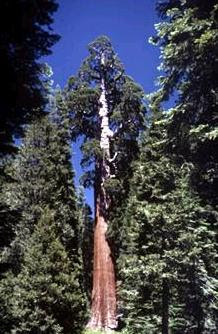Sequoia
Sequoia (tree), also known as redwoods, common name for a group of huge, majestic evergreen trees characterized by a columnar, reddish-brown trunk rising 30 m (100 ft) or more above a buttressed base. Sequoia species are conical in shape, with needlelike leaves and small, oval cones. The trees are named for the Cherokee leader Sequoyah.
 Giant Sequoia
Giant Sequoia
The giant sequoia, or “big tree,” is found in a narrow strip about 300 km (about 200 mi) long on the western slopes of the Sierra Nevada range at elevations between about 900 and 2400 m (about 3000 and 8000 ft). It is the most massive of all living forms. The leaves of the giant sequoia are scalelike and lie close to the branches. The bark of the trunk is fluted and is spongy in texture; in large trees it reaches a thickness of 60 cm (2 ft). The wood is light, coarse-grained, and highly resistant to insects and fire.
Coast Redwood
The coast redwood grows along the humid Pacific coast from southern Oregon to central California. Its height ranges from 30 to 112 m (100 to 367 ft), a size approached only by the eucalyptus of Australia, one specimen of which measures at least 97 m (at least 318 ft). The diameter of the trunk measures up to 7.5 m (25 ft). The life span of the coast redwood is believed to be 2500 years. The leaves are bluer in tone than the giant sequoia and are more needlelike. The wood is similar but even-grained. Unlike most other conifers (cone-bearing trees), the stump of the coast redwood produces sprouts after cutting that can grow to considerable size in just 40 years.
Dawn Redwood
The dawn redwood was at one time the most common sequoia tree in North America and is thought to be ancestral to the California redwood. It attains a height just under 30 m (100 ft) and averages 1.8 m (6 ft) in diameter. Its leaves are flat and grow in slender, opposite branches. Unlike the evergreen sequoias, the dawn redwood is a deciduous tree.
Scientific classification: Sequoias belong to the family Taxodiaceae. The giant sequoia is classified as Sequoiadendron giganteum, the coast redwood as Sequoia sempervirens, and the dawn redwood as Metasequoia glyptostroboides.
Sequoia (tree), also known as redwoods, common name for a group of huge, majestic evergreen trees characterized by a columnar, reddish-brown trunk rising 30 m (100 ft) or more above a buttressed base. Sequoia species are conical in shape, with needlelike leaves and small, oval cones. The trees are named for the Cherokee leader Sequoyah.
 Giant Sequoia
Giant SequoiaThe giant sequoia, or “big tree,” is found in a narrow strip about 300 km (about 200 mi) long on the western slopes of the Sierra Nevada range at elevations between about 900 and 2400 m (about 3000 and 8000 ft). It is the most massive of all living forms. The leaves of the giant sequoia are scalelike and lie close to the branches. The bark of the trunk is fluted and is spongy in texture; in large trees it reaches a thickness of 60 cm (2 ft). The wood is light, coarse-grained, and highly resistant to insects and fire.
Coast Redwood
The coast redwood grows along the humid Pacific coast from southern Oregon to central California. Its height ranges from 30 to 112 m (100 to 367 ft), a size approached only by the eucalyptus of Australia, one specimen of which measures at least 97 m (at least 318 ft). The diameter of the trunk measures up to 7.5 m (25 ft). The life span of the coast redwood is believed to be 2500 years. The leaves are bluer in tone than the giant sequoia and are more needlelike. The wood is similar but even-grained. Unlike most other conifers (cone-bearing trees), the stump of the coast redwood produces sprouts after cutting that can grow to considerable size in just 40 years.
Dawn Redwood
The dawn redwood was at one time the most common sequoia tree in North America and is thought to be ancestral to the California redwood. It attains a height just under 30 m (100 ft) and averages 1.8 m (6 ft) in diameter. Its leaves are flat and grow in slender, opposite branches. Unlike the evergreen sequoias, the dawn redwood is a deciduous tree.
Scientific classification: Sequoias belong to the family Taxodiaceae. The giant sequoia is classified as Sequoiadendron giganteum, the coast redwood as Sequoia sempervirens, and the dawn redwood as Metasequoia glyptostroboides.



